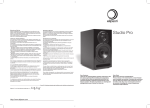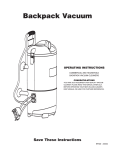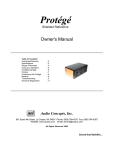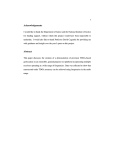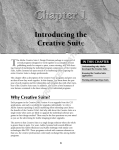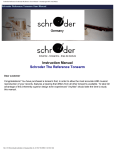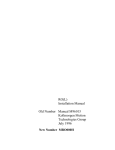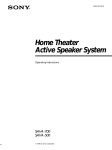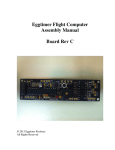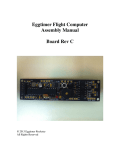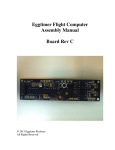Download Dayton Audio A732 User`s Manual
Transcript
Loudspeaker Kit Assembly Instructions Dayton A732 Speaker Kit Manual © 2008 Dayton Audio® Introduction The Dayton A732 (Aluminum, 7 inch woofers, 3 speaker, 2 way) kit is a fully aluminum system that delivers the great resolution and low distortion that aluminum drivers are famous for. From the powerful bass to the extended high frequencies, these make excellent speakers for rock or other high-impact music. Crossed at 2 kHz, the Dayton DA175-8 aluminum woofer is free to operate in its best range, and it can do midbass very well. The smooth sounding Vifa D25AG-35 tweeter picks up from there and carries the highs out past 20 kHz. . Parts Inventory Before beginning the assembly process, please inspect and confirm that you have all necessary components. If you appear to be missing any components, please contact your place of purchase immediately. Part # MTM(C)-1.0 BAFFLE XOVER MANUAL BPA-38G PTUBEADJ FOAM PANS634 DA175-8 D25AG-35 JANTZ.33 JANTZ.4 JANTZ.9 DMPC-6.8 DMPC-10 DMPC-12 DMPC-15 5O12W DNR-8.0 TIES SILICONE CAULK Qty 1 1 1 1 1 1 1 19 2 1 1 1 1 1 1 1 1 1 1 5 1 1 Description 1.0 cu. ft. MTM cabinet Custom baffle Crossover board w/wires Instruction Manual Gold binding post pair 2-1/2" Adjustable port tube 1-1/2" x 24" x 18" Acoustic foam #6 x 3/4" Phillips pan head screws Dayton DA175-8 7" Aluminum cone woofer Vifa D25AG35-06 Tweeter Jantzen .33 mH 18 ga (L1) Jantzen .4 mH 18 ga (L2) Jantzen .9 mH 18 ga (L3) Dayton 6.8 uF cap (C1) Dayton 10 uF cap (C2) Dayton 12 uF cap (C3) Dayton 15 uF cap (C4) 5 ohm resistor (R1) Dayton 8 ohm resistor (R2) Cable ties Silicone adhesive Speaker sealing caulk Loudspeaker Kit Assembly Instructions By following these instructions and assembling the speaker in a conscientious manner, you will be able to enjoy your speaker for many years to come. If there are any questions during the assembly process, please contact your place of purchase. Gather the Necessary Tools The assembly of your speaker kit requires several basic tools and supplies, though more advanced tools can be used if desired. The following list represents the basic tools that are required: Hammer Small wrench or pliers Silicone adhesive or hot-melt glue gun Scissors or utility knife (for cutting foam) Workspace Considerations #2 Phillips head screwdriver or power driver Soldering gun & solder Wire cutters Workspace Considerations As with doing any type of kit assembly, it is best to have a large, clean work area with adequate lighting. Taking a few minutes to establish a good work area will save time by eliminating lost parts and prevent assembly errors. A heat-resistant work surface is recommended for the crossover assembly portion. When working with the cabinets, it is important to cover the work surface with a cloth or foam layer to protect the speaker finish. The foam wrap that is around the speaker cabinets will work well for this, making sure it is free from dust or other debris. Getting Organized To prepare for the kit assembly, you need to do some basic unpacking and organizing first. Open the large speaker cabinet box and remove the speaker from the packaging. You will need to unwrap the cabinet itself, saving the wrap to protect your work surface. Remove the baffle from the cabinet, and place the baffle screws someplace safe. Proceed to unpack binding posts and other packaged items. Assembly 1. Install Port Tube The port tube that is included with your kit needs to be installed into the cabinet. In this particular kit, the port size is 2-1/2" in diameter by 8" in length. You will need to make the port the appropriate length by adjusting the sliding straight portion of the tube. When properly adjusted, it should measure 8" from the end of the outer tube to the outer surface of the mounting flange. Applying adhesive to the joint will permanently set the tube length; a thin film of silicone or a few drops of cyanoacrylate glue will be sufficient to hold everything in place. Screw-mount port tubes- The port can simply be set into place and carefully secured with the included #6-3/4" screws. Be careful not to over-torque the screws, which may result in cracking of the plastic. 2. Install Binding Posts The posts will need to be “knocked” into place with a hammer and secured from the inside of the cabinet. Start by placing the cabinet face-down onto the work surface, being sure that the cabinet is firmly supported. Remove the binding posts from their package, and unscrew all washers and nuts from the shaft. Next, remove the main nut that is used to hold the speaker wire onto the terminals- this will prevent them from getting damaged while the posts are being inserted. Insert one of the post shafts into the hole and align it making sure the wire through-hole is running vertically. Gently tap into place until the shoulder is snug with the rear of the cabinet. NOTE: Excessive hammering is not necessary and may cause damage to the finish of the cabinet around posts. Proceed through the same process with the second post. Once the posts have been knocked into place, you will need to secure them from the inside of the cabinet. A lock washer followed by a nut need to be installed to secure the posts to the cabinet. Next, install the second lock nut, the solder tab, the second nut, and then tighten into place. Now that the posts are fully secured, reinstall the colored knobs on the outside of the cabinet. When looking from the rear of the cabinet (terminals should be closer to the “bottom” of the cabinet), the “red” terminal is normally positioned on the right side. 3. Install damping material The damping material included is intended to line the walls of the cabinet to reduce midrange reflections and help prevent standing waves. The included foam will need to be cut to size and then secured onto the walls of the cabinet. Note: On most kits there will be excess material available, it is not necessary to use all of it. Do not place foam directly on top of or underneath the crossover boards. For this system, you will be lining one of each set of opposing walls, rather than lining the whole cabinet. Using too much foam (particularly in this small cabinet) can cause an overdamped bass reflex system, which may result in an unfavorable bass response. Alternating the foam location between walls is recommended. For example, use one piece of foam on the right side wall on the front half of the cabinet. Use a second piece on the left wall behind the brace. For the top and bottom, use one piece of foam on the bottom front half, and one piece on the top rear half above the port. This will reduce direct reflections between parallel walls on all surfaces without overdamping the system. This configuration also works well by leaving us plenty of room for installing the crossover board. The damping material can be secured to the walls with a spray adhesive or with hot-melt glue. When using spray adhesive, please follow the manufacturer’s instructions. It is best to apply the spray to the foam itself, being sure to spray away from the cabinet to prevent getting adhesive on the cabinet exterior. When using hot-melt glue, simply place a few drops of glue at various locations on the rear of the foam and press into place. 4. Install drivers in baffle The drivers need to be secured to their baffles with the included #6 screws. For all driver installations, some form of gasketing material should be used between the driver frames and the baffles to prevent air leaks and vibrations. However, in this system, both the woofer and tweeter have integral foam mounting gaskets, so no additional driver sealant is necessary. The drivers can now be carefully lowered into place on the baffle. Having the terminals facing towards the bottom of the cabinet is the generally accepted orientation, though it is not a critical matter. Using the included screws and predrilled pilot holes, carefully tighten the drivers down onto the baffle. Pay particular attention to not over-tighten screws on drivers with stamped steel or polymer frames, which can cause deformation of the flange. 5. Crossover Assembly Instructions For the system to perform properly, it is important that the crossover be assembled correctly. Incorrect assembly can cause damage to the speaker drivers or your amplifier, so please take time to work carefully and to check your work as you go. The crossover boards have a printed pictorial layout on them that includes an outline of the component and a part label. Please refer to the parts list and schematic for a list of which components go in each location. Match the component label from the description on the parts list to the label on the PC board. Each component will have two leads that correspond to holes on the PC board. Put the components into place with the leads going through their appropriate holes, following the pictorial on the board. Directionality on the components is not important; either end of each component can go into either hole. It is recommended that each component be secured to the board with hot-melt or silicone to prevent any possible vibration of components. Cable ties are recommended on the inductors to hold them in place more firmly, especially if you are using silicone. Once all of the components have been secured and have their leads going through the board, we can flip it over and make the solder connections. On the inductors, make sure that the “silver” tinned section of the lead is what you are soldering to. Attempting to solder to the copper-colored or red insulated portion of the inductor lead will result in a failed connection. To solder effectively, place the soldering iron tip so that it is touching both the component lead and the PC board. This will allow both portions to heat simultaneously, and will ensure a good flow of solder between the two. After heating the board and leads for several seconds, add solder to the joint to form an effective connection. A good solder joint will have a conical shape, and will not look “blobby” or “spherical.” After all connections are made, the remaining component leads on the rear of the board can be trimmed down with a pair of side cutters or other electrical cutters. We can now add the connecting wires for the inputs and drivers. Connect the input, output, and tweeter wires to the respective terminals on the PC board. The wire with the .25" terminals is the input wire. The remaining long, medium, and short wires will go to the top woofer, tweeter, and lower woofer respectively. Make sure that the positive terminals are connected to the positive (red) wires in all locations. 6. Test the speaker At this point, it is recommended that you take some time to test the speaker before final installation of the crossover and baffle. You should already have the cabinet assembled and lined with foam, the drivers should be in the baffles, and the crossover should be assembled. Connect these three parts together to do a quick check that everything is working correctly. Place the crossover board into the cabinet in the approximate final location; it does not need to be secured right now. Connect the input wires to the binding posts on the rear of the cabinet, making sure the red wire is going to the red post. Now, attach the output wires from the crossover board to their respective drivers. Insert the baffle with the drivers on it into the cabinet, and secure with one or two of the baffle machine screws if needed. If the baffle will stay in place on its own, it is not necessary to secure it. Now, we need to connect the speakers to your stereo system. At this point we are not worrying about air leaks or the bass response. We are just doing a quick check that the drivers and crossover are working correctly. Play music through the speaker, checking that both the woofer and tweeter are working, and that the overall sound is full and smooth. Even though everything is not completely secured, you should still be able to get a good idea of what the overall sound will be like. If a driver is not working or the sound is intermittent or distorted, please see the troubleshooting section for possible remedies. Be sure that you are satisfied that everything is working correctly before moving on to permanently installing the crossover or baffle. 7. Install the crossover Now that you are satisfied that everything is working correctly, permanently secure the crossover board. The recommended location for the crossover board is the bottom rear of the cabinet. Once again, securing with silicone or hot-melt glue is the recommended fastening method. If using hot-melt glue, it is recommended to place the glue on the surface of the cabinet and then press the board into it. This prevents the glue from cooling too rapidly or dripping onto the cabinet or the body, causing injury. If you are using silicone, it is easier to apply the glue to the back of the PC board. Making sure that the mounting location is horizontal, place the board into its location. You will need to allow the silicone to cure for an hour or so before you change the orientation of the cabinet. Once the board is in place, you can connect the input wires to the speaker binding posts. 8. Install the baffle Now you will need to connect the output wires from the crossover to the terminals on the drivers and place the baffle into the cabinet. With the baffle leaning against the cabinet, make all driver connections, once again paying attention to the polarity of the connections. Note: The red wires will attach to the terminals that are marked with a red color or with a + sign. The baffle can now be installed into the cabinet, working carefully to make sure no wires are trapped between the baffle and the cabinet. Once the baffle is fully installed, it can be secured via the included machine screws and glued into place if desired. Using the 4 machine screws by themselves will have adequate holding power to prevent leaks and vibrations of the baffle. However, for the utmost cabinet strength, the baffle should be glued into place with polyurethane glue. Note: Once the baffle is glued into place, making any changes to the speaker becomes very difficult. Please listen to the speaker for a period of time with just the machine screws holding the baffle in place to make sure everything is working correctly before you secure the baffle permanently. 9. Install Grill The grill has four neodymium magnets which are embedded into the frame. These magnets are arranged to align with the screws that hold the baffle in place. Simply place the grill on the baffle and realign if necessary. 10. Care and cleaning To protect the finish of your Dayton speaker system, it is important to use some care when it comes time to clean it. To remove dust from drivers, grills, or the cabinet tops, a synthetic “feather duster” works well. For more stubborn dust on the grills or woofers, a vacuum cleaner with gentle brush attachment may be used. It is not recommended to use any type of cleaning apparatus on tweeter domes; dust will not affect the sound, and the chance of damaging the dome is high. For cleaning streaks or fingerprints on the cabinet finishes, an ammonia-based window cleaner is recommended. It will not affect the finish and will leave a streak-free shine. It is important to use only very soft, clean cloths, and to wipe gently at the surface. Intense scrubbing or using cloths with debris on them may cause small swirl marks or scratches. Of course, the best way to maintain the finish on the cabinet is to prevent soiling it in the first place. Never place drinks or abrasive objects on the top of the speaker. Troubleshooting Problem: No output from woofer in individual speaker. Cause: Bad connection or defective woofer. Solution: Check connections from crossover board to woofer. If this is OK, check solder connections in the crossover, particularly on inductors. If this is OK, directly test the woofer by hooking it up to stereo system at low volume setting. If sound comes out of the woofer, then go back and check connections. If there is no sound at all, then woofer is likely defective. Please contact your place of purchase immediately. Problem: No output from tweeter in individual speaker. Cause: Bad connection or defective tweeter. Solution: Check connections from crossover board to tweeter. If this is OK, check solder connections in the crossover. If OK, it is possible to carefully test the tweeter by directly connecting it to your stereo. Test at a very low volume for a brief period of time, at the level of a loud whisper. If there is high-frequency sound, then go back and check connections. If no sound at all, then tweeter is likely defective. Please contact your place of purchase immediately. . Problem: There is sound from the speaker, but it is very quiet and seems to be mostly treble or midrange. Cause: Woofer and tweeter are wired backwards. Solution: Immediately cease testing to prevent damage to the tweeter. Check connections from crossover board to woofer and tweeter, making sure the T terminal goes to the tweeter and the W goes to the woofer. Problem: There is sound from the speaker, but it doesn’t sound normal. Cause: Crossover board is wired incorrectly. Solution: Double check that the input from the speaker terminals is connecting to the inputs on the crossover board. If this is correct, check that all components are of the correct value and in the right location. Problem: Intermittent output of entire speaker, woofer, or tweeter. Cause: Bad connection in wires or crossover board. Solution: If entire speaker is intermittent, then check connections between the input terminals and the crossover board. If just woofer or tweeter is intermittent, check the wires going to the drivers. If these are OK, check the connections of the components within the appropriate section of the crossover. Problem: In stereo, speakers lack bass or image is unfocused. Cause: Speakers are out of phase. Solution: Check connections from amplifier to the speakers. Make sure polarity is the same on both speakers. If correct, check the polarity of connections going from binding posts to input on crossovers. If this does not correct the problem, check polarity throughout the rest of the system, looking for one driver that is wired incorrectly. Problem: One speaker appears louder than the other. Cause: Amplifier settings, environmental factors, psychoacoustics, poor connection in crossover. Solution: Check your amplifier to ensure that the balance is set even. Next, check that one speaker isn’t closer to a wall, window, couch, or other acoustically important object. This may affect perceived loudness due to the addition or reduction of extra sound reflections. If this is the case, physically switch the left and right speakers, and re-observe. If the same location still sounds quieter, then it is the environment. If the quiet speaker moves, then you may have a problem within the speaker. Often, if you think one speaker is louder than the other, it will appear so. Have someone help you do a blind test or take a break and allow time for your brain to relax. The next day, if one still seems louder, investigate all connections within the crossover. Problem: Speakers play well, but amplifier shuts down. Cause: Amplifier does not have enough power or cannot handle speaker impedance. Solution: If using 4 ohm speakers, check receiver/amplifier manual to see if it can handle 4 ohm speakers or if it has a low impedance setting. If not, upgrade your amplifier. If the receiver/amplifier can safely handle the speaker load, then it may simply not have enough power.








